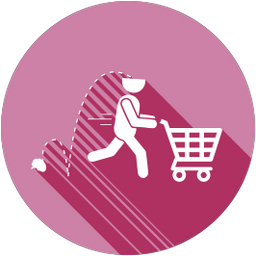What Psychology Knows about Impulse Buying in 2020
Relevant topics Research, Archive
Did you know consumers spend $5.400 per year on average on impulse purchases of food, clothing, household items, and shoes?
That shouldn’t be quite a surprise. In one way or another, everyone has experienced a sudden, often powerful, and persistent urge to buy something immediately. In most cases, this regards something we hadn’t planned for.
It could be that one time you visited your local grocery store and realized there had been a huge discount on your favorite Italian rice. Or that time you walked into a high-end jewelry shop and suddenly purchased that sparkling golden Swedish watch on the shelf, regardless of the financial risks involved.
Now that was our impulse buying urge in full effect.
So how can we trigger these inherent impulse buying desires that consumers already have to stimulate impulse purchases?
Key Triggers of Impulse Buying
Trait Related Determinants
Several individual traits and self-identity variables may serve as internal sources of impulse buying.
Psychological impulses influence impulse buying. Prior neuromarketing research shows that people who score high on impulsivity trait measures are more likely to engage in impulse buying.
Moreover, other traits are associated with impulse buying. They include:
• Sensation seeking: An inclination to seek novel experiences and sensations regardless of the risks involved.
• Impulse buying tendency: An enduring tendency to act in a given context. This well-recognized concept captures an enduring consumer trait that produces an urge or motivation for actual impulse buying. Impulse buying tendencies are relatively easy to observe and predictive of impulse buying.
• Self-identity: These are specific beliefs about self-identity and its deficits that a person holds of her- or himself. For example, this means that the lady purchasing the Swedish watch at the high-end jewelry shop isn’t actually buying it because she needs to keep track of time. She’s doing it because she feels that it is going to make her friends and associates treat and perceive her differently.
Motives and Norms
Consumers’ motives are important internal sources of impulse buying that reflect goal-directed arousal. These lead to specific beliefs about consumption. For example, consumers may believe that buying objects will provide emotional gratification, compensation, rewards, or else cut their negative feelings.
Such beliefs may be especially relevant if the objects are unique and feature a marked opportunity cost so that they need to be purchased immediately.
Norms invoked by consumers about their impulsiveness also might affect impulse buying decisions. Consumers’ own prior impulse buying experiences may serve as a basis for independent, internalized evaluations of impulse buying as either bad or good.
From a self-regulation perspective, when prior impulse buying evokes positive experiences, consumers likely engage in it again, as a promotion-focused strategy.
Resources
Consumers with greater physical resources or interest in a product category are more likely to engage in impulse buying, whereas those who lack necessary resources such as time and money engage less in impulse buying.
Age and gender might capture shopping-related resources, such that impulse buying tendencies often are more prevalent among specific social or demographic cohorts. Younger shoppers may be more likely to buy while older adults may be better able to regulate their emotions and engage in self-control.
Also, men and women are likely to buy different products to buy and use different buying considerations when buying on impulse. Women are more likely than men to experience regret or a mixture of pleasure and guilt.
Marketing Stimuli
According to research, 62% of in-store purchases are made impulsively and online buyers are more likely to be impulsive. This means impulse buying can be sparked by various marketing stimuli such as:
Communication: All marketing and sales mediums (advertising, direct sales, salesperson, pop-up ads, salesperson, in-store promotional display) must speak to the core desires of your customers. So instead of ‘selling the watch’ and only talking about the features, you can talk about the prestige associated with owning one.
Price: Marketers can encourage impulse purchases by lowering prices and giving discounts, running sales promotions, and by increasing the perceived value of the product sold.
Store ambiance: Marketers can create visual and sensory stimuli in online and offline stores to attract consumers. This can be achieved by optimizing layout and display, to enhance visual appeal triggering impulse purchases.
Merchandise: Retailers need to devise new, unique marketing stimuli to convey the value of their offers and encourage impulse buying. This can be achieved by creating a variety of new products and redesigning old products.
The Psychological Workings of Impulse Buying
Self-control
Self-control involves individuals' attempts to curb their desires, conform to rules, and change how to think, feel, or act.
All individuals differ in self-control leading to the view that self-control is an inherent strength or trait.
The failure of self-control could occur due to conflicting goals, reduction in self-monitoring, or depletion of mental resources. The depletion of mental resources, or ‘ego depletion’, may also be temporal, i.e., more likely to occur at the end of the day. The ‘ever-shifting conflict between desire and willpower’ demonstrates the importance of self-control as a key mediator in impulse buying.
Emotions
Consumers who engage in impulse buying tend to display emotions at any moment during the buy (i.e. before, during, or after).
Impulse buying behavior relates to positive emotions and feelings. Impulse buyers experience more positive emotions such as delight and thus spend more. Impulse buyers have a strong need for arousal and experience an emotional lift from persistent repetitive purchasing behaviors. Such arousal might even be a stronger motive for impulse buying than product ownership.
Now while pleasure is an important precursor, negative mood states such as sadness can also be associated with impulse buying.
For example, various studies suggest self-gifting is a form of retail therapy that helps customers manage their moods.
Boundary Conditions
Since it is the individuals, not the products, who experience the impulse to consume, you should identify the impulse buying–prone customers if you are looking to harness the full power of impulsivity. Then, come up with new promotional offers specifically devised to attract them.
A great way retail storeowners can come up with compelling offers is by bundling similar products and offering discounts.
Take-Home Points:
• Consumers may believe that buying objects will provide emotional gratification, compensation, rewards, or else cut their negative feelings.
• About 62% of in-store purchases are made impulsively and online buyers are more likely to be impulsive.
• Retailers need to devise new, unique marketing stimuli to convey the value of their offers and encourage impulse buying.
• Store atmospherics and price discounts are powerful triggers of impulse buying.
• Consumer resources such as time and money affect impulse buying, so encouraging impulse buying may require reducing the impacts of resource constraints.
Further Reading
-
Are Chatbots Catching Up To Human Salesmen?
Most likely, you'll recognize that vague feeling when talking to a customer support chat service, that the "person" you're chatting with might actually be a computer.
Indeed, the market size of chatbots is expanding: starting at $250 million in 2017, it will be more than $1.34 billion in 2024 (Pise, 2018). A chatbot is an automated speech generator that can respond to both written and auditory text. More than 21% of US adults and even more than 80% of generation Z (born between 1996 and 2010) use voice/text bots for information search and shopping.


